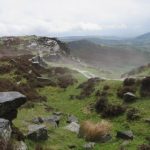The Neolithic In Dorset And Derbyshire
When I moved to the Peak District, I anticipated that my Neolithic understanding gained in Dorset would be an advantage. However, that has not happened even though the similarities are many. Both counties have calcareous soils, Dorset with chalk and the Peak District, well my part at least, is limestone. Neither are heavily forested. Both, even today, have low populations and remain very rural. Water, in both, is pure and sparkling. It often erupts from springs and these seem to have had a spiritual value to early peoples. That said, the well dressings in Derbyshire appear ancient and yet have a very short history. The Neolithic in Dorset and Derbyshire are difficult to reconcile.
The differences
For instance, movement across land was a real challenge in those early times. There is little evidence of tracks earlier than the Iron Age. In Dorset, that was not an issue because the rivers were navigable. That is not the case in the Peak District, with its shallow, rapid rivers. In Dorset, huts framed in wood with thatch roofs have been found but not so in the Peak. Such building skills meant dryer, warmer huts and a higher survival of children. The thatch, whether from reeds or grain crops, seem not to have been available in the Peak.
The Romans
Although Roman reports contained lots of anomalies, they did record that people in Britain lived on milk and flesh. That suggest a perspective that suits the wilder parts such as the Peak District. Tribes in these areas may well have been herding cattle, moving higher in summer and lower in winter. Because of that movement, such tribes tend not to create permanent huts. Finding their dwellings, over 4000 years later, is the problem we still face.
The Neolithic in Dorset and Derbyshire
These early people needed light soils, ones they could plough using a wooden ard. In Dorset, they had the water meadows. Such soils do not exist in Derbyshire. Because they grew grain on the water meadows in Dorset, they built storage granaries. Such granaries are not found in Derbyshire. It was that grain, sheer calories, that built Stonehenge. We forget, in these modern times, how the land forged people and their success or failure. What we need is more archaeology in the Peak District but I doubt that will happen.




